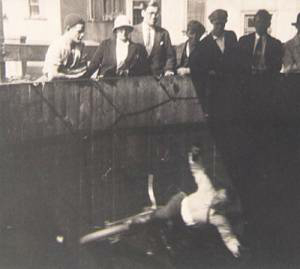Racers at these amateur events weren't paid like the pros were. They largely raced for the love of it. A hat would be passed through the crowd and a collection taken up that would be divided among the amateur racers to help cover costs. Hepburn's kind nature soon endeared him to the other racers, when at one of these early events a fellow racer took a spill and was injured. Hepburn, feeling bad for his friend's poor luck, used his entire share of the collection, a whole 30 cents, to buy his friend some malted milk balls to cheer him up. The other racers liked young Hep, taking him under their wing and mentoring him.
January 1st of 1914 young Hep placed 3rd in a 3 mile open at Lordsburg, CA., his first professional top 3 finish. After some encouragement from friends and fellow racers, he decided to turn pro. Later that year Hep boarded a train bound for Detroit to compete in a race at the Detroit Speedway. At a stop at a train station in Missouri, he was greeted with the news that the Detroit track had closed and all future events were canceled. Stranded with no job and no destination, Hepburn learned of a nearby traveling carnival that was in need of a rider to perform in their Wall of Death show, a daredevil exhibition where a rider performs on a vertical, circular wall. Hep traveled with the carnival for the rest of 1914 and for part of 1915.
In 1915 Hepburn returned home and took a job at an Excelsior dealership. Racing was still in his blood and he soon purchased a used, race modified Excelsior twin from a friend and began to rebuild it with plans of returning to the track. He was soon competing again in sanctioned races, turning in regular top 3 finishes.
After a widely publicized crash in McPherson Kansas, where multiple riders were injured, the factory backed teams withdrew their large V-twins from competing on the short 1/2 mile tracks, believing them too dangerous. Hep borrowed an Indian single and continued to compete. He was also lent a Harley Davidson single by Ray Weishaar. His success on the smaller, borrowed Harley attracted the attention of the Big Shots back at Harley Davidson.
Just like other racers of the era, Hepburn's career was put on hold by WW1 in 1917. He entered training with the fledgling US Air Service. The war ended and Hep was discharged in 1918, just before finishing his training. In the meantime, the war years had put Harley Davidson in position to dominate racing upon its return. In addition to producing machines for the war effort, the company had continued to develop their racing department. Rival Indian, on the other hand, had focused solely on supplying the war. Bill Ottaway, head of Harley's racing department wasted no time. In spring of 1919, he was busy recruiting the best racing talent he could find upon their return from service, hardly waiting for the ink on their discharge papers to dry. Ralph Hepburn was one of the first chosen.
His fellow Harley Davidson teammates comprised of legendary names like Otto Walker, Red Parkhurst, "Shrimp" Burns, Fred Ludlow, and Ray Weishaar. Together they formed the original "Wrecking Crew."
In June of 1919, Ralph won the 200 mile National Championship at L.A.'s Ascot Park, setting a new record of 72.32 mph (116.39 km/h). He began the 1920 season taking second place behind Otto Walker in a 100 mile Championship, again at Ascot Park. Hep and his teammates dominated race after race throughout 1920, with Hep claiming over a dozen National wins and many top three finishes. His success continued through 1921, with no less than 33 National wins on dirt and board tracks. Most notable was his victory at the 1921 Dodge City 300, where Hep finished in 1st place a full 12 minutes of Indian's Johnny Seymour.
In 1922 Harley Davidson's interest in professional racing slowed, but Ralph's didn't. He quickly signed with Indian and continued to collect trophies through the 1923 season. 1924 found Hep back astride a Harley, still leading the pack. Hep took a little time out in 1924 to marry his sweetheart Ida, whom he called "Sparky" and set off to Australia for their honeymoon, but not without bringing along his motorcycle...
The spring of 1925 found Hep racing at the Melbourne Motordrome, in the land down under. He took a little more time away from his bride to set a new speed record of 113 mph (181.86 km/h) at Sellick's Beach, Adelaide before returning to the states.
Upon his return to the U.S., his interest in motorcycle racing took a back seat to a new passion. In prior years, Hepburn had been dabbling in the quickly growing sport of automobile racing. In 1925, he entered and raced in the Indianapolis 500. The remainder of his life was spent chasing victories with 4-wheeled racers. Out of 15 entries in the Indianapolis 500, he achieved 4 top 5 finishes. He served as President of the American Society of Professional Automobile Racers. He even acted in Hollywood films about racing, most notably 1932's The Crowd Roars, with James Cagney.










No comments:
Post a Comment